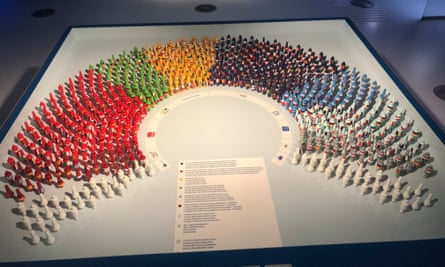There is a virtual reality plane trip, a quiz, a presentation from the world’s “most powerful woman”, and a souvenir photo: it is all part of the offer at one of the latest tourist attractions to arrive in Brussels – the European Commission exhibition centre.
Experience Europe, which has been open just under a year, seeks to explain the work of the commission, which proposes and enforces EU law, and for many is the epitome of “Brussels”. It is the latest example of how the bloc is trying to appeal to the public. Stung by criticism of being an elite project with bamboozling and opaque processes, the EU has sharpened up communication efforts in the last 15 years. The European parliament opened a visitors’ centre, the Parlamentarium, in 2011, followed by a museum dedicated to European history in 2017.
Even the most secretive EU institution, the European Council, where ministers and government leaders negotiate, has a visitors’ centre and an app. On “EUcraft” players can negotiate laws on behalf of their governments; for example, lobbying to delay the introduction of a ban on single-use plastics – a fair reflection of how governments tend to slow down ambitious EU proposals.
Located off a traffic-clogged roundabout opposite the commission headquarters in Brussels, the €4.2m (£3.7m) Experience Europe space has features common to other EU museums and exhibitions in Brussels: it is free and largely paperless. Touchscreens are more efficient to ensure content is available in several languages.
At Experience Europe, visitors can put on heavy, virtual-reality headsets to get a 360-degree view from inside a Spanish firefighting plane, or an EU aid mission to a Bangladesh refugee camp. “Meeting the European Commission president”, Ursula von der Leyen – recently declared by Forbes to be the world’s “most powerful woman” – turns out to be hearing her reflections on being the commission’s first female leader and how she spends her free time. She tells viewers she likes to listen to Adele while running through the forest, as well as taking care of ponies and chickens in her German country house.
Elsewhere there are short films about fictional Europeans, such as a jaunty romance involving an Italian farmer called Federico that weaves in references to EU policies on regional produce, capitals of culture and the abolition of roaming charges. The quiz is also policy heavy, with a few leading questions. The statement that the EU “lags behind in the development of artificial intelligence” is apparently “fiction”, when it is at least debatable.
Opened with little fanfare, Experience Europe is not trying to compete with Brussels’ biggest tourist attractions, instead aiming for a modest 30,000 visitors a year.

When the Guardian calls in, only two visitors are there, but they are enthusiastic. “We really like it and agree it’s a pity we are here almost alone,” says Tomas Novotny, a 29-year-old research analyst, who is on a weekend break to Brussels from Prague. “In the Czech Republic people have concerns about the future of our country and they are looking for someone to blame for current problems and it usually [is] the European Union.”
He and his travelling companion, Tomas Braha, took part in the EU’s Erasmus exchange programme in Ireland, an experience they think sets them apart from the older generation. If people were better informed they would not believe what they read on disinformation websites about the EU, Novotny says. “I think this kind of exhibition should be everywhere in every country,” Braha adds.
Their enthusiasm may not be widely shared. On the Guardian’s return visit, the only people to see the gleaming touchscreens and flashing electronic tickers are the staff. A commission spokesperson said 20,000 people visited in the first 10 months of opening.
It is much busier at the Parlamentarium, where students are queueing for security checks. The European parliament’s visitors’ centre is much larger and claims to be one of the most visited museums in Brussels, having welcomed 2.5 million people since opening in 2011. Telling the history of the continent from the first world war to Brexit, it also informs people about how the parliament works, with pen portraits of its 705 members. The exhibition is updated quickly. After Britain left the EU, British MEPs were removed overnight. Eva Kaili, the Greek politician charged with bribery and corruption, remains on the wall of MEPs but without formal titles or party affiliations – she was stripped of her responsibilities and expelled from the Socialists and Democrats group after being charged. Kaili has denied any wrongdoing through her lawyers.

Othmar Karas, a European parliament vice-president, said the accusations against Kaili and others were “shocking” and had “potential to hurt the reputation of the European parliament and the trust of citizens in the EU institutions”. Nevertheless, Karas, who co-leads the parliament’s work on public information, was optimistic that places such as the visitors’ centre helped the EU reach people. “Only if you talk to each other, interact and explain the way the EU is working and how we all benefit you can keep the spirit of our common Europe alive,” he said in emailed answers during an illness.
It will probably never be enough to appeal to the very toughest audience – a bored German teenager on a school trip. Ivan, 17 from Dusseldorf, said he and his friends largely skipped the exhibition and complained: “It’s way too much information. It repeated the history we learned about already in school.”
Shahid, an international business student from Groningen in the Netherlands, was more positive. “It was actually a good experience to get all this new information,” she said, adding there was a lot about the war and founding of the EU she hadn’t known.
Alberto Alemanno, an EU law professor at HEC business school in Paris, estimates he has accompanied around 1,000 adult students to Brussels, who have largely enjoyed the various EU offerings. “Any attempt by the institutions, or anybody else, to create a more entertaining experience, which might provide [the public] with direct exposure to what decision making might look like and to humanise the bubble … should be welcomed.”
Bu it might not be enough, he said, urging the EU to engage with the public as citizens and not just tourists. He would like to see a “European citizens’ house” in Brussels, where people could, for example, find out how to meet and contact EU commissioners, or sign petitions.
Otherwise, he argues, “there is a risk we have invested hundreds of millions of euros to create beautiful museums that are quite entertaining for the usual suspects. We haven’t necessarily addressed the actual needs of people travelling to Brussels in trying to understand how they can engage with institutions.”
.

 1 year ago
86
1 year ago
86










 English (US)
English (US)